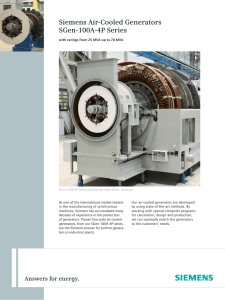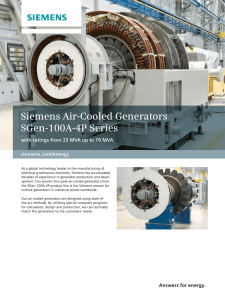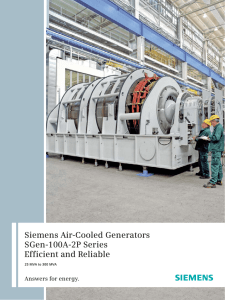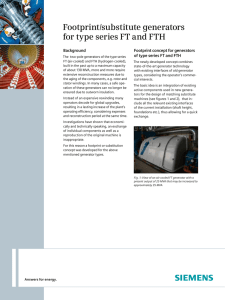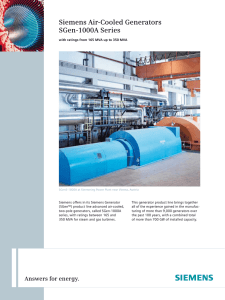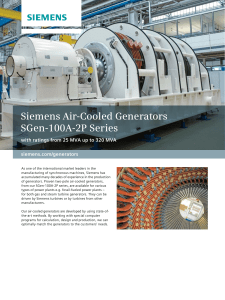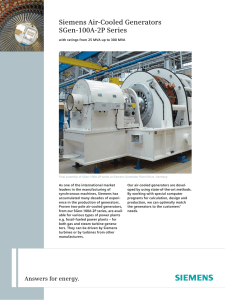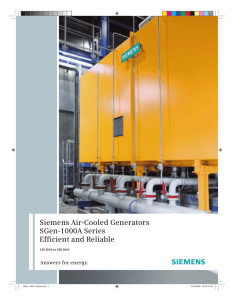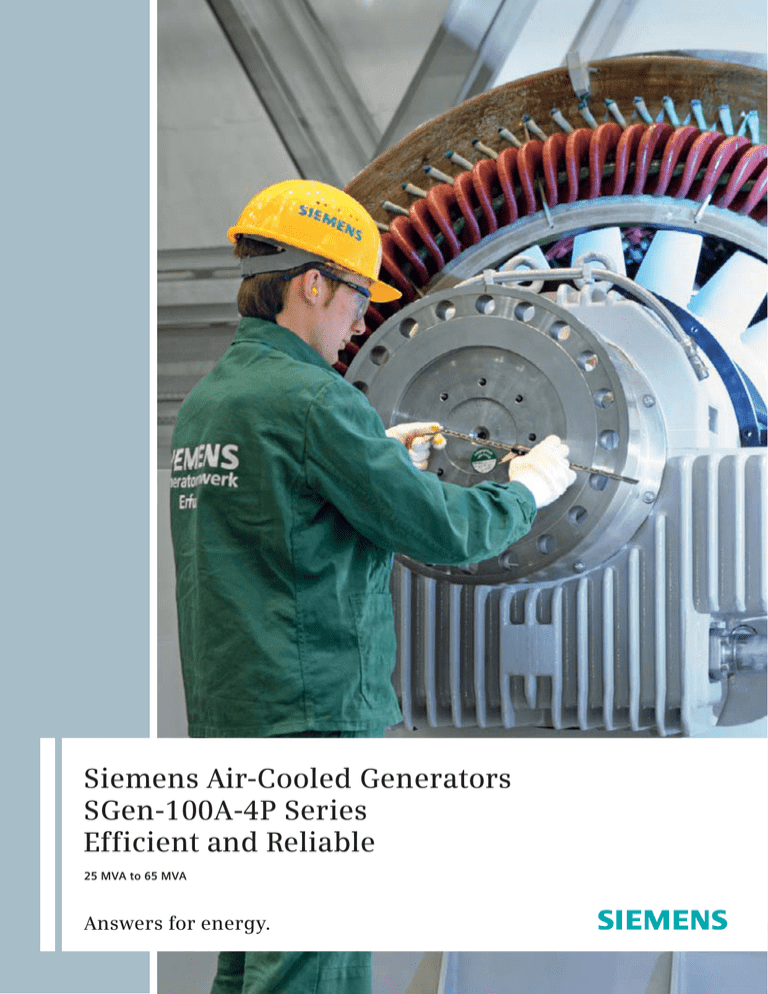
Siemens Air-Cooled Generators
SGen-100A-4P Series
Efficient and Reliable
25 MVA to 65 MVA
Answers for energy.
Four-pole three-phase synchronous generator
As one of the international market leaders
in the manufacturing of synchronous machines, Siemens has accumulated many
decades of experience in the production
of generators. Proven four-pole air-cooled
generators, from our SGen-100A-4P series,
are the Siemens answer for turbine generators in industrial plants.
Our air-cooled generators are developed
by using state-of-the-art methods. By
working with special computer programs
for calculation, design and production,
we can optimally match the generators
to the customers’ needs.
Outstanding design features of the
Siemens’ air-cooled SGen-100A-4P series
generators include:
■ high efficiency,
■ low noise emissions,
■ low installation and
commissioning costs,
■ high serviceability and
■ long service life.
For each customer project, a customized
generator is developed according to the
individual technological specifications,
output and customer needs. Using a
building-block system, the required generator type is designed by choosing from
different diameters and by making adjustments to length. This enables us to supply
our customers with generators specially
tailored to their requirements. As an option, the generator can also be supplied
with a gearbox.
Siemens four-pole three-phase synchronous generators are used as high-voltage
generators with a solid salient-pole rotor.
Their rotor windings are indirectly cooled
by air.
These generators use brushless excitation
as a standard. The exciter power is supplied by an exciter with rotating rectifiers.
The exciter is a stationary-field machine
with the rotor mounted on the generator
shaft. Alternatively, static excitation using
slip rings is also available.
The standard design is IM 1005 featuring
a frame with bracket bearings.
Industrial power plants equipped with
steam and gas turbines, and SGen-100A-4P
series generators keep process costs down
due to high efficiency levels of cogeneration. This ensures a considerable degree of
independence from public power supply.
Technical data
Frequency
Model
Power factor
Apparent power
Efficiency
Terminal voltage
50 Hz
SGen5-100A-4P
0.80 to 0.90
25 MVA to 65 MVA
up to 98.5 %
6.3 kV to 13.8 kV
60 Hz
SGen6-100A-4P
0.80 to 0.90
25 MVA to 65 MVA
up to 98.5 %
6.3 kV to 13.8 kV
6
6
5
2
8
3
4
7
1
1 Plain bearings with circulating-oil
lubrication
2 Stator winding and insulation are
form-wound coils featuring Siemens
epoxy-mica (MICALASTIC®) insulation
technology
3 Field coils attached to the rotor body
with solid pole shoes
4 Salient-pole rotor with solid pole shoes
5 Frame bottoms half and core are
stable welded structures and carry
the laminated stator core and endshield bearings
6 The coolers are implemented either
in TEWAC1, CACA2 or DAC3 cooling
systems
7 Monitoring system and leads laterally
attached on the bottom half of the
frame
8 Exciter set either static or brushless
with or without Permanent Magnet
Generator (PMG)
1 TEWAC = Totally Enclosed Water-to-Air Cooling
2 CACA = Closed Air-to-Air Cooling
3 DAC = Direct Air Cooling (cooling air intake via filter)
Published by and copyright © 2009:
Siemens AG
Energy Sector
Freyeslebenstrasse 1
91058 Erlangen, Germany
Siemens Energy, Inc.
4400 Alafaya Trail
Orlando, FL 32826-2399, USA
For more information, please contact
our Customer Support Center.
Phone: +49 180 524 70 00
Fax:
+49 180 524 24 71
(Charges depending on provider)
E-mail: support.energy@siemens.com
Fossil Power Generation Division
Order No. E50001-G210-A123-X-4A00
Printed in Germany
Dispo 34802, c4bs No. 7449
TH 214-090488 430340 WS 05093.
Printed on elementary chlorine-free
bleached paper.
All rights reserved.
Trademarks mentioned in this document
are the property of Siemens AG, its affiliates,
or their respective owners.
Subject to change without prior notice.
The information in this document contains
general descriptions of the technical options
available, which may not apply in all cases.
The required technical options should therefore
be specified in the contract.
www.siemens.com/energy

